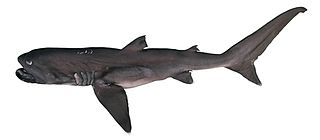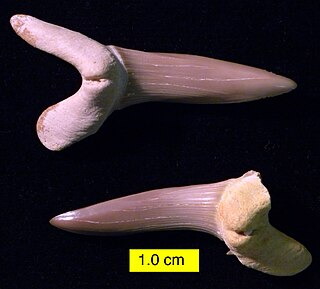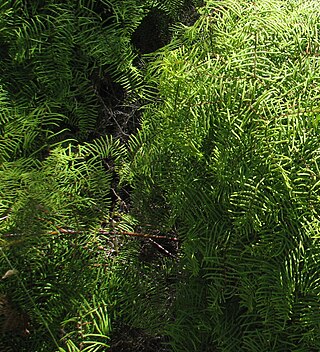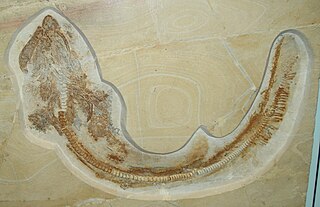
Eutheria, also called Pan-Placentalia, is the clade consisting of placentals and all therian mammals that are more closely related to placentals than to marsupials.

Carcharhiniformes, the Requiem sharks, are the largest order of sharks, with over 270 species. They include a number of common types, such as catsharks, swellsharks, and requiem sharks.

The Lamniformes are an order of sharks commonly known as mackerel sharks. It includes some of the most familiar species of sharks, such as the great white as well as less familiar ones, such as the goblin shark and megamouth shark.

Cretoxyrhina is an extinct genus of large mackerel shark that lived about 107 to 73 million years ago during the late Albian to late Campanian of the Late Cretaceous. The type species, C. mantelli, is more commonly referred to as the Ginsu shark, first popularized in reference to the Ginsu knife, as its theoretical feeding mechanism is often compared with the "slicing and dicing" when one uses the knife. Cretoxyrhina is traditionally classified as the likely sole member of the family Cretoxyrhinidae but other taxonomic placements have been proposed, such as within the Alopiidae and Lamnidae.

Chlamydoselachus is a genus of sharks and the sole extant member of the family Chlamydoselachidae, in the order Hexanchiformes. It contains two extant and four extinct species. The most widely known species still surviving is the frilled shark. It is known as a living fossil, along with Chlamydoselachus africana, also known as the southern African frilled shark, which is only found along coastal areas of South Africa. The only two extant species of this genus are deep-sea creatures which are typically weakened in areas closer to the surface. While the two extant species are similar in external appearance, they differ internally.

Megachasma is a genus of mackerel sharks. It is usually considered to be the sole genus in the distinct family Megachasmidae, though suggestion has been made that it may belong in the family Cetorhinidae, of which the basking shark is currently the sole extant member. Megachasma is known from a single living species, Megachasma pelagios.

Hybodus is an extinct genus of hybodont that lived from the Middle Triassic to the Late Cretaceous periods. Species closely related to the type species Hybodus reticulatus lived during the Early Jurassic epoch. Numerous species have been assigned to Hybodus spanning a large period of time, and it is currently considered a wastebasket taxon that is 'broadly polyphyletic' and requires reexamination.

Phuwiangosaurus is a genus of titanosaur dinosaur from the Early Cretaceous (Valanginian-Hauterivian) Sao Khua Formation of Thailand. The type species, P. sirindhornae, was described by Martin, Buffetaut, and Suteethorn in a 1993 press release and was formally named in 1994. The species was named to honor Princess Maha Chakri Sirindhorn of Thailand, who was interested in the geology and palaeontology of Thailand, while the genus was named after the Phu Wiang area, where the fossil was discovered. The precise affinities of Phuwiangosaurus among titanosauriform sauropods are uncertain, though several studies have classified it as a euhelopodid.

Scapanorhynchus is an extinct genus of goblin shark that lived during the Cretaceous period, from the Aptian to the end of the Maastrichtian. Later records, such as those from the Miocene assigned to the species S. subulatus, are highly dubious and may be misidentified sand sharks.

The Pierre Shale is a geologic formation or series in the Upper Cretaceous which occurs east of the Rocky Mountains in the Great Plains, from Pembina Valley in Canada to New Mexico.

The Paleocene, or Palaeocene, is a geological epoch that lasted from about 66 to 56 million years ago (mya). It is the first epoch of the Paleogene Period in the modern Cenozoic Era. The name is a combination of the Ancient Greek παλαιός palaiós meaning "old" and the Eocene Epoch, translating to "the old part of the Eocene".

Hybodontiformes, commonly called hybodonts, are an extinct group of shark-like cartilaginous fish (chondrichthyans) which existed from the late Devonian to the Late Cretaceous. Hybodonts share a close common ancestry with modern sharks and rays (Neoselachii) as part of the clade Euselachii. They are distinguished from other chondrichthyans by their distinctive fin spines and cephalic spines present on the heads of males. An ecologically diverse group, they were abundant in marine and freshwater environments during the late Paleozoic and early Mesozoic, but were rare in open marine environments by the end of the Jurassic, having been largely replaced by modern sharks, though they were still common in freshwater and marginal marine habitats. They survived until the end of the Cretaceous, before going extinct.

Gleichenia is a genus of ferns. Its closest relative is the genus Stromatopteris, restricted to New Caledonia.

Paraorthacodus is an extinct genus of shark. It a member of the family Paraorthacodontidae, which is either placed in Hexanchiformes or in Synechodontiformes. It is known from over a dozen named species spanning from the Early Jurassic to the Paleocene, or possibly Eocene. Almost all members of the genus are exclusively known from isolated teeth, with the exception of P. jurensis from the Late Jurassic-Early Cretaceous of Europe, which is known from full body fossils from the Late Jurassic of Germany, which suggest that juveniles had a robust body with a round head, while adults had large body sizes with a fusiform profile. There was only a single dorsal fin towards the back of the body without a fin spine. The dentition had teeth with a single large central cusp along with shorter lateral cusplets, which were designed for clutching. The teeth are distinguished from those of Synechodus by the lateral cusplets decreasing in size linearly away from the central cusp rather than exponentially as in Synechodus.
Psilichthys is an extinct genus of prehistoric bony fish from Eumeralla Formation, the Lower Cretaceous epoch of what is now Victoria, Australia, known from single species P. selwyni. This is the first Mesozoic fossil vertebrate named from Victoria.

Lonchidion is a genus of extinct hybodont in the family Lonchidiidae. The genus first appears in the fossil record during the Middle Triassic (Ladinian) and was among the last surviving hybodont genera, with its youngest known fossils dating to the very end of the Cretaceous (Maastrichtian).
Johnlongia is an extinct genus of sand shark from the Cretaceous period. It contains two described species, J. parvidens and J. allocotodon, and possibly a third unnamed species from the Niobrara Chalk. It is presumed piscivorous; however, it forms a clade with an early filter-feeding shark genus, Pseudomegachasma.

Haimirichia is an extinct genus of mackerel shark from the late Cenomanian epoch of the Cretaceous period. It currently contains a single species: H. amonensis. Teeth now assigned to this genus were originally attributed to the Odontaspis. Exquisitely preserved remains from the Akrabou Formation Lagerstätte in Agoult, Morocco allowed the species to be moved into a new genus and family. Microscopic study revealed specialized dermal denticles likely used in electroreception. Its tooth and head design suggest a lifestyle similar to the extant Whitetip reef shark, a novel one for Lamniformes. Roulletia has a similar tooth design and may be part of the same family, Haimirichiidae.

Egertonodus is an extinct genus of shark-like hybodont fish. It includes E. basanus from the Jurassic of Europe and North Africa and Cretaceous of North America, North Africa and Europe, and E. duffini from the Middle Jurassic of England. Indeterminate remains of the genus have been reported from the Early Cretaceous of Asia. E. basanus is known from preserved skull material, while E. duffini is only known from teeth. The genus is distinguished from Hybodussensu stricto by characters of the skull and teeth. E. basanus, the most common species, is thought to have reached 1.5 m in length. E. fraasi from the Late Jurassic of Germany, known from a poorly preserved full body fossil, was placed in Egertonodus in one study, but this has been subsequently questioned by other authors, due to strong differences in tooth morphology from the type species. Fossils have been found in freshwater and lagoonal environments.

















